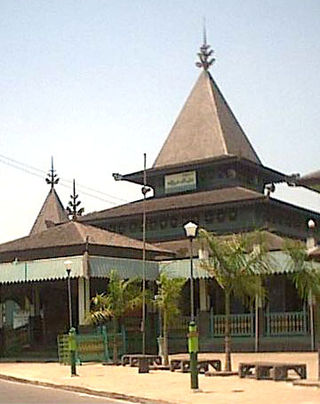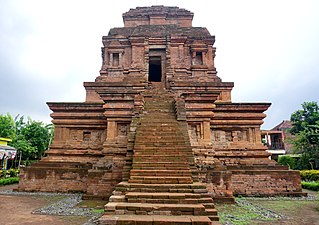
Prambanan is a 9th-century Hindu temple compound in the Special Region of Yogyakarta, in southern Java, Indonesia, dedicated to the Trimūrti, the expression of God as the Creator (Brahma), the Preserver (Vishnu) and the Destroyer (Shiva). The temple compound is located approximately 17 kilometres (11 mi) northeast of the city of Yogyakarta on the boundary between Central Java and Yogyakarta provinces.

A step pyramid or stepped pyramid is an architectural structure that uses flat platforms, or steps, receding from the ground up, to achieve a completed shape similar to a geometric pyramid. Step pyramids are structures which characterized several cultures throughout history, in several locations throughout the world. These pyramids typically are large and made of several layers of stone. The term refers to pyramids of similar design that emerged separately from one another, as there are no firmly established connections between the different civilizations that built them.

Javanese sacred places are locations on the Island of Java, Indonesia that have significance from either village level through to national level as sacred, and in most cases deserve visitation—usually within the context of ziarah regardless of the ethnicity or religion of the visitor. The dominant form for many places is a sacred grave, or a place associated with persons considered to have special attributes in the past—like Wali Sanga or Royalty.

The Sultan Suriansyah Mosque is the oldest mosque in South Kalimantan. Built in 1526 during the reign of Sultan Suriansyah, the first Banjar King to convert to Islam. The mosque is located in the village of Kuin Utara, in Banjarmasin.

The Manjusrigrha inscription is an inscription dated 714 Saka, written in Old Malay with Old Javanese script. The inscription was discovered in 1960 on the right side of the stairs entrance of Sewu pervara no. 202 on the west side. This inscription is linked to the Sewu temple. According to this inscription, the original name of the Sewu temple compound is probably Manjusrigrha. Sewu temple is located approximately 800 meters north of Prambanan temple, Central Java, Indonesia. The inscription was carved on an andesite stone block measured 71 cm x 42 cm x 29 cm.

Cultural properties of Indonesia are those items defined by Indonesian law as of "important value for history, science, and culture", and include both man-made artefacts and natural objects. The cultural properties number more than 8,000 and include ancient Hindu and Buddhist temples, mosques, historic colonial buildings, forts, art galleries, national parks and beaches. A number of the sites are World Heritage Sites.

Kadisoka is a partially excavated temple, thought to be Hindu, in Sleman Regency, Special Region of Yogyakarta, Indonesia. It is listed as a Cultural Property of Indonesia.

Prajñāpāramitā of Java refers to a famous depiction of Bodhisattva Prajñāpāramitā Devi, originating from 13th century Singhasari, East Java, Indonesia. The statue is of great aesthetic and historical value, and is considered to be a masterpiece of classical Hindu-Buddhist art of ancient Java. Today, the statue is in the collection of the National Museum of Indonesia, Jakarta.

Gunung Wukir temple, or Canggal temple, or also known as Shivalinga is a Shivaite Hindu temple dated from the early 8th century, located in Canggal hamlet, Kadiluwih village, Salam subdistrict, Magelang Regency, Central Java, Indonesia. The temple dates to the year 732, making it the first structure attributed to the ancient Mataram kingdom, which ruled Central Java from 732 to around the middle of the tenth century.
Arca Totok Kerot or Recå Thothokkerot IPA: [rətʃɔ ʈɔʈɔʔ kərɔt] is a statue located in Bulusari Village, Pagu District, Kediri Regency, Indonesia; about 2 kilometers north-east of Simpang Lima Gumul. It is made of andesite stone, depicting a giant with a terrifying face. The style is that of a dvarapala. Based on the style, it is suggested that it was made in the 10th century.

Kedulan temple is the ruin of a 9th-century Hindu candi located not far from Sambisari temple. The temple is in Tirtomartani village, Kalasan subdistrict, Sleman Regency, Yogyakarta, Indonesia. The style and architecture bear striking similarities to the nearby Sambisari temple. And just like Sambisari, the temple compound is buried around 6 metres (20 ft) below the present surface, as the result of lava flow from the last eruption of Mount Merapi in the north.

Al-Wustho Mangkunegaran Mosque is a historic mosque located in the Central Javanese city of Surakarta, to the west of the Mangkunegaran Palace. The mosque is one of the three oldest mosques of Surakarta. Al-Wustho Mangkunegaran Mosque was inaugurated as a state mosque of the Mangkunegaran Palace.

Jawa Timur Park, commonly known as Jatim Park, East Java Park, Eastern Java Park, or JTP, is a complex of recreational and learning parks located in Batu, East Java, Indonesia. The complex has 3 parks, Jatim Park 1, Jatim Park 2, and Jatim Park 3. Jatim Park is one of the tourism icons of East Java and one of the most famous amusement parks in Indonesia.

Bubrah is a 9th-century Buddhist temple located within the complex of the Prambanan Temple Archaeological Park, in Central Java, Indonesia. Experts believe that the temple was designed as a part of the greater Sewu temple compound.

Gunung Gangsir is an 11th-century Hindu candi (temple) located approximately 5 kilometers west from the town of Bangil. This red brick structure is located in Gunung Gangsir village, Beji subdistrict, Pasuruan Regency, East Java Indonesia.

Sumberawan is a Buddhist stupa located in Toyomarto village, Sumberawan subdistrict, Malang Regency, East Java, Indonesia. The stupa is located in the highlands, on the southern slope of Mount Arjuno, surrounded by numerous Springs.

The Tomb of Ratu Mas Malang is a tomb and cultural site located in near the village of Plered in the Bantul Regency of Indonesia. It is the tomb of Queen Malang, one of the wives of Amangkurat I of Mataram. The tomb was built using white stone, and construction finished in 1668. The tomb has since been damaged by environmental factors.

Bumiayu temple compound, or locally known as Candi Bumiayu, is a Sumatran Shivaist Hindu temple complex located near the banks of Lematang river, precisely in Bumiayu village, Tanah Abang district, Penukal Abab Lematang Ilir Regency, South Sumatra, Indonesia. The temple located about 120 kilometres west of Palembang city. The red brick structures are estimated dated from 8th to 13th-century, and linked to the Srivijaya kingdom. Compared to Java, only a few Hindu-Buddhist temple ruins has been rediscovered in Sumatra. The temple is known as one of the few surviving Hindu temple remnant in South Sumatra. Other temple ruins in Sumatra are Muaro Jambi in Jambi, Muara Takus in Riau, and Bahal temple in North Sumatra.

Tuntang Station (TTG) is a class III railway station located in Tuntang District, Semarang Regency, Central Java, Indonesia. The station is located at an altitude of +464 meters and is operated by Operation Area IV Semarang. The station only serves excursion trains from the Ambarawa Railway Museum




















